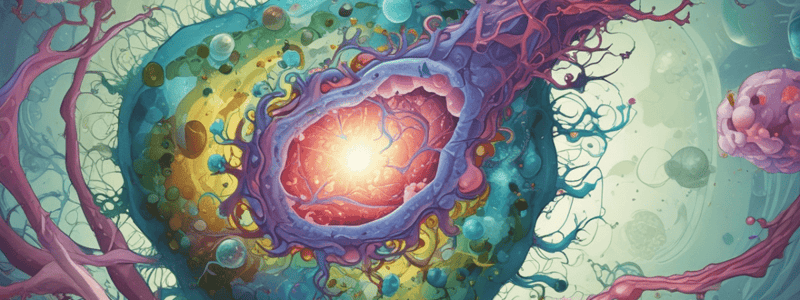Podcast
Questions and Answers
What is the primary function of the cell membrane?
What is the primary function of the cell membrane?
- To facilitate the building of proteins
- To transmit genetic information to the next generation
- To control what enters and leaves the cell (correct)
- To provide structure and support to the cell
What is the role of ribosomes in cells?
What is the role of ribosomes in cells?
- To facilitate the building of proteins (correct)
- To regulate cell functioning
- To control cell division
- To provide the instructions for building the cell’s machinery
What is the most basic unit of structure and function in all living organisms?
What is the most basic unit of structure and function in all living organisms?
- Tissue
- Organ
- Organ system
- The cell (correct)
What is the substance inside the cell membrane?
What is the substance inside the cell membrane?
What is the genetic material needed to provide instructions for building the cell’s machinery?
What is the genetic material needed to provide instructions for building the cell’s machinery?
What is the result of the combination of hundreds of years of observations and experiments?
What is the result of the combination of hundreds of years of observations and experiments?
What is the main difference between prokaryotes and eukaryotes?
What is the main difference between prokaryotes and eukaryotes?
What is the function of the cytoskeleton?
What is the function of the cytoskeleton?
What is the purpose of the cell membrane?
What is the purpose of the cell membrane?
What is the function of organelles?
What is the function of organelles?
What is the function of the nucleus?
What is the function of the nucleus?
What is the difference between the nucleoid region and the nucleus?
What is the difference between the nucleoid region and the nucleus?
What is the main function of the cytoplasm?
What is the main function of the cytoplasm?
What do all cells have in common?
What do all cells have in common?
Flashcards are hidden until you start studying
Study Notes
Cell Theory
- All known living things are composed of one or more cells.
- All new cells are created by pre-existing cells dividing.
- The cell is the most basic unit of structure and function in all living organisms.
Cell Structure
- Cells have a cell membrane, which acts as the boundary or edge of the cell and controls what goes in and out.
- Cells contain cytoplasm, the substance inside the cell.
- Cells have DNA, the genetic material needed to provide instructions for building the cell's machinery.
- Cells have ribosomes, the structures that facilitate the building of proteins.
Cell Function
- All functions essential to life occur within the cell.
- During cell division, the cell transmits to the next generation the information necessary to conduct and regulate cell functioning.
Cell Variation
- Cells can vary widely in appearance and function.
- Many cells also contain more structures, in addition to the basic cell membrane, cytoplasm, DNA, and ribosomes.
Cell Characteristics
- Despite diversity in structure and function, all cells share certain characteristics.
Cell Types
- There are two main types of cells: prokaryotes and eukaryotes.
- Prokaryotes are small, simple cells that make up single-celled organisms, with bacteria being the most prevalent type.
- Eukaryotes are larger, more complex cells that are often multicellular organisms, including plants, animals, and fungi.
Common Cell Features
- All cells have a cell membrane that provides a barrier between the interior and exterior of the cell and regulates the flow of substances in and out of the cell.
- All cells have cytoplasm, the fluid that occupies the space inside the cell, where chemical reactions that enable life take place.
- All cells have a cytoskeleton, a network of filaments that provide support and a framework for the cell to move things around in the cytoplasm.
- All cells contain DNA, which contains the instructions for synthesizing all the cell's proteins, at some point in their life cycle.
- All cells contain ribosomes, the molecular machines that use the instructions contained in the DNA to build all the proteins needed by the cell.
Eukaryotic Cell Features
- Eukaryotic cells are more complex and have specialized structures called organelles.
- Organelles have their own membrane to partition them off from the rest of the cell and to allow them to specialize in a certain function.
- An important example of an organelle is a nucleus, a specialized compartment found in eukaryotic cells for holding DNA.
Prokaryotic Cell Features
- Prokaryotic cells have DNA, but it is localized to one area of the cell, the nucleoid region.
- The nucleoid region is not surrounded by a membrane and is therefore not a nucleus.
- Only eukaryotic cells have a nucleus.
Studying That Suits You
Use AI to generate personalized quizzes and flashcards to suit your learning preferences.




